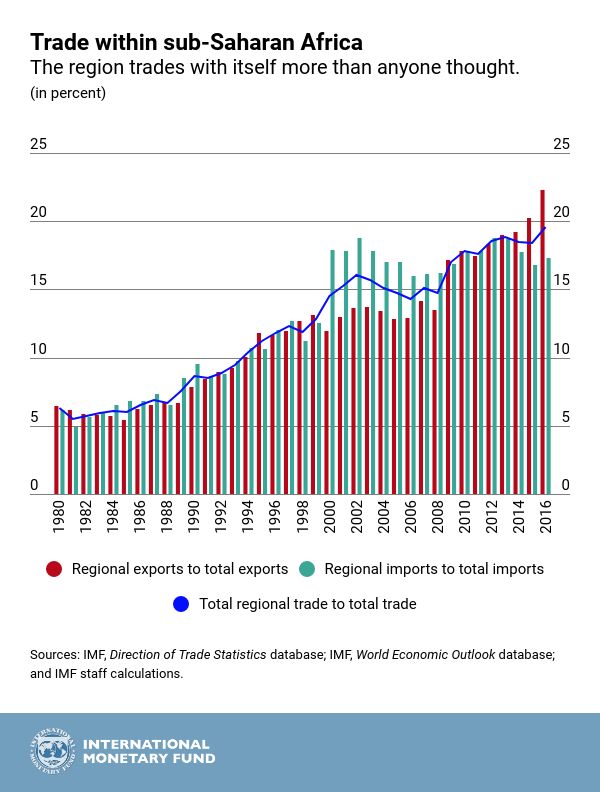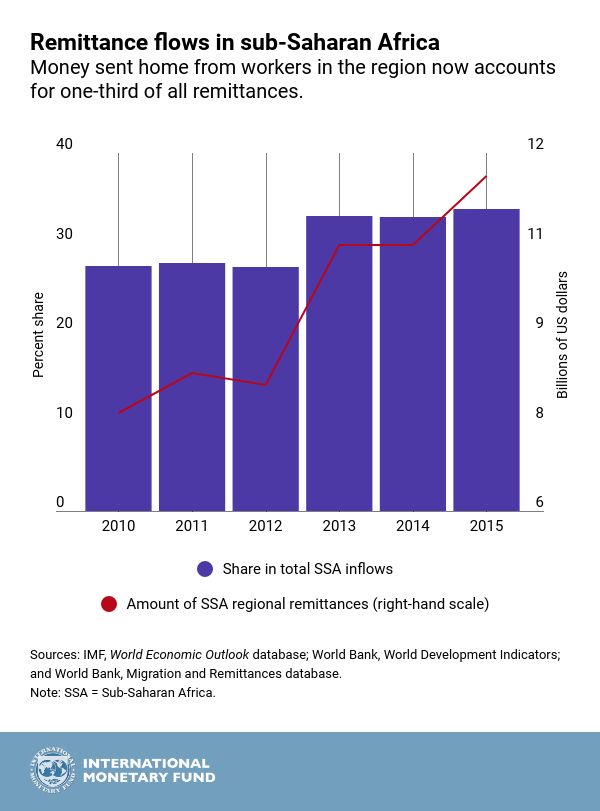August 1, 2018
Versions in Français, Português
[caption id="attachment_23997" align="alignnone" width="1024"] Countries in sub-Saharan Africa are more closely tied than ever, thanks to rising trade with one another and remittances (photo: AfricaImages/Getty Images by iStock)[/caption]
Countries in sub-Saharan Africa are more closely tied than ever, thanks to rising trade with one another and remittances (photo: AfricaImages/Getty Images by iStock)[/caption]
Contrary to popular belief, countries in sub-Saharan Africa are more closely tied than ever, thanks to rising trade with one another and remittances—the money people send home when working in another country.
Our new study shows that closer ties expose countries to each other’s good and bad fortunes. Booming large economies spur partners’ growth by demanding more of their goods, and because people working in a booming economy will send home more remittances. Downturns in one country impact another by the same means. So, tighter economic ties also raise challenges.
We find trade to be the strongest conduit when it comes to the impact on growth.
Trade and remittances drive closer ties
Integration between the economies of sub-Saharan Africa has increased most substantially through trade. In 1980, regional exports were equal to only 6 percent of total exports, but by 2016 they had risen to 20 percent.
This makes the extent of regional integration in sub-Saharan Africa as high as in any other emerging and developing region in the world. This is the result of the region’s higher growth relative to the world, the reduction of tariffs, and stronger institutions and economic policy, relative to the past, throughout the continent.
The bulk of this trade, however, occurs within rather than between sub-regions—smaller groups of geographically close countries within sub-Saharan Africa. For example, the five countries that make up the Southern African Customs Union, Botswana, Lesotho, Namibia, South Africa and Swaziland, account for 50 percent of total sub-Saharan African trade.
Integration within the region has also increased thanks to the wages sent home by workers living in another country. In 2015, these amounted to about US$11.5 billion.
Total remittances to sub-Saharan Africa have been broadly stable in percent of GDP over the last ten years, but their composition has changed. By 2015, intra-regional remittance flows accounted for one third of total remittances. As with trade, intra-regional remittance flows are large by global standards, about 0.6 percent of GDP, and greater than those in emerging and developing Asia, Europe, and the Americas, which are all less than 0.3 percent of GDP.
Developments in financial technology—notably mobile banking—continuously reduce the cost of sending remittances. Even though remittance costs are less affected by distance than trade costs, remittance flows mostly take place within the sub-region. Cameroon in Central Africa, Côte d’Ivoire and Ghana in the West, South Africa in the South and, to some extent, Kenya in the East are large sources of remittances for the continent.
Impact on growth
We find trade to be the strongest conduit when it comes to the impact on growth. We estimate that a 1 percent increase in the weighted growth rate of intra-regional partners is associated with an increase of 0.11 in domestic growth.
We show that the largest economies in the region, like Nigeria and South Africa, which currently have sluggish and slow growth, impact the countries most exposed to them through reduced demand for traded goods and a reduction in remittance flows.
Conversely, fast-growing economies, like Côte d’Ivoire and Kenya, will buoy other West and East African economies respectively with higher growth from increased demand for traded goods and larger remittance inflows.
Boosting integration further
Sub-Saharan integration has caught up to other emerging and developing regions’ levels, but enormous potential remains for further improvements, especially between sub-regions. Countries can:
- Reduce tariff and non-tariff barriers, such as reducing administrative burdens and improving the ease of doing business, including broad ratification and implementation of the African Continental Free Trade Agreement.
- Prioritize infrastructure development, for countries who have room in their budgets, to make trade easier between countries and between sub-regions.
Moreover, to deal with the increased risks raised by closer ties, countries can also:
- Diversify their economies through structural transformation and the diversification of exports, while building on their comparative advantage.
- Ensure policies are in place to monitor and regulate, where necessary, cross border trade of goods and services, including effective and efficient customs and border procedures.
Over the next few years, greater integration in the African continent, including by leveraging the continental free trade agreement, is a welcome sign of development.
It means a broader base for business to expand and more employment opportunities for workers. Through these channels, integration has the potential to significantly raise medium-term growth, foster stability, and reduce debt sustainability concerns for many countries.
The region is playing more collectively, which means greater chances to win at growing all their economies.




